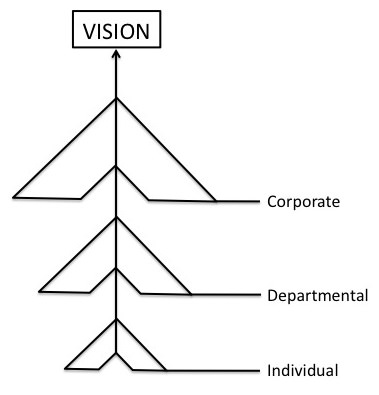
I find that some clients have trouble differentiating between types of Rocks. Does a Rock belong at the company, departmental, or individual level? To provide context, I’ve found three effective ways to teach the concept: the inverted Christmas tree, the construction project, and the magnitude and impact filter.
1. The Inverted Christmas Tree
Early in my EOS Implementer® journey, I drew an image that looked like this:

I used it to explain the different kinds of Rocks and how the company’s vision impacts Rock selection.
Rather than drawing literal Rocks, I drew lines on the whiteboard. Stepping back, I realized those lines connected to resemble branches on a tree.
I sketched out how the energy from individual Rocks flowed up to departmental Rocks. Then I showed how departmental Rocks flowed up to company Rocks, which ultimately served to advance the company’s vision.
In my diagram, the chevron at the top represents the Company Rocks. Departmental Rocks form the middle layer. And individual Rocks make up the bottom and smallest branches. The “tree” trunk points skyward, showing how the vision aligned and informed Rock selection, ultimately helping achieve the company’s goals.
The graphic helped the leadership team visualize and embrace the concept better than any words could.
2. The Construction Project
Another way to think about Rock categorization with leaders is to look at the priorities like a construction project. Here the construction workers build the owner’s vision (for example, a dream house).
The general contractor owns the company Rocks and serves as the Integrator™. They ensure that the most important tasks (company Rocks) get done to advance the dream house vision on budget and on time.
Think of the departmental Rocks as things that need to get done by the subcontractors. Consider each subcontractor (electrical, plumbing, or roofing) as a department with its own set of priorities for the dream home project. So the complete installation of wiring in the house would be a departmental Rock.
The subcontractor needs materials to complete their work. A supply house delivering the bill of materials to the job site would be considered an individual Rock in this analogy.
3. Magnitude and Impact Filter
Gauging the magnitude and impact of a Rock helps leaders figure out at which level of the company a Rock belongs.
Company Rocks
The leadership team identifies the three to seven most important things that need to get done each quarter to advance the organization’s vision. These items will have the greatest magnitude and impact on moving a business forward.
Departmental Rocks
Then departmental leaders determine the most important things the department needs to accomplish in the next quarter. These projects serve to “move the needle” for departmental goals, ultimately serving the company goals.
Individual Rocks
Finally, individuals list the most important things they personally need to achieve in the next 90 days in their role. Individual Rocks support the department’s progress and, again, indirectly serve the greater good of the entire organization.
These are just a few examples of analogies to help a leadership team better understand the differences between the different Rocks for their business. Because once they can compartmentalize Rocks into appropriate levels, the entire team focuses on what will serve the greater good of the organization.





